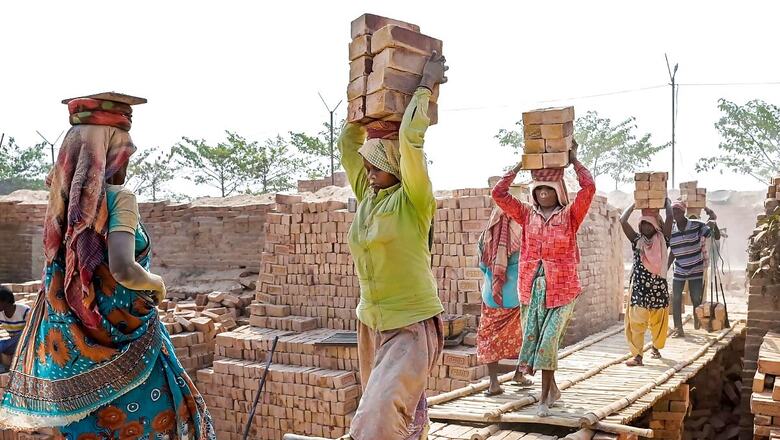
views
Even though the demand for work under the Mahatma Gandhi National Rural Employment Guarantee Scheme (MGNREGS) showed a downward trend in the first three months of 2023, April and May have seen a significant rise in the total number of households demanding work in the new fiscal.
At 3.17 crore households, the month of May has seen the highest demand over the past five years, barring the pandemic year, shows official data.
Data shows that the new financial year, starting April, has seen the demand go up, which until March remained quite low. A total of 3.17 crore households demanded work in May 2023, as against the same month in 2.61 crore in 2022-23, 2.65 crore in 2021-22, 3.73 crore in 2020-21 and 2.47 crore in 2019-20.
April, too, saw a rise, both as compared to the first three months of 2023 as well as against the corresponding month in previous years. In the new fiscal, April saw 2.40 crore households demanding work under the scheme. This figure for the month of April was 1.86 crore in 2022-23, 2.61 crore in 2021-22, 1.34 crore in 2020-21 and 2.10 crore in 2019-20.
According to the data, the first three months of the post-pandemic year saw demand for work under MGNREGS drop close to pre-pandemic levels — 1.89 crore, 1.67 crore and 1.66 crore, respectively.
The increase in number of households demanding work under the scheme is being attributed to two factors — extension of the Aadhaar-based payment system (ABPS) deadline from April 1 to July 1 and more families looking for work since the harvest season is over.
Here’s a look at the month-wise data on the number of households that demanded work under MGNREGS since 2019-20.
May
- 2023-24 – 3.17 crore
- 2022-23 – 2.61 crore
- 2021-22 – 2.65 crore
- 2020-21 – 3.73 crore
- 2019-20 – 2.47 crore
April
- 2023-24 – 2.40 crore
- 2022-23 – 1.86 crore
- 2021-22 – 2.61 crore
- 2020-21 – 1.34 crore
- 2019-20 – 2.10 crore
March
- 2022-23 – 1.89 crore
- 2021-22 – 2.40 crore
- 2020-21 – 2.62 crore
- 2019-20 — 2.07 crore
February
- 2022-23 – 1.67 crore
- 2021-22 – 2.37 crore
- 2020-21 – 2.86 crore
- 2019-20 – 2.22 crore
January
- 2022-23 – 1.66 crore
- 2021-22 – 2.33 crore
- 2020-21 — 2.63 crore
- 2019-20 — 1.88 crore
The rise in demand appears to be contrary to what the Centre had stated earlier this year on drop in demand due to the economy bouncing back to normal post-pandemic.
MGNREGS activists had claimed that the drop in demand was actually people not being able to avail the scheme due to three changes — steep budget cut, introduction of the National Mobile Monitoring System (NMMS) to mandatorily mark workers’ attendance digitally on the app and the Aadhaar-Based Payment System (ABPS) for transfer of wages, even though a large number of workers still don’t have Aadhaar-linked bank accounts.
Even as the fresh deadline for states to switch completely to ABPS is around the corner, at least 25% of the total active workers are yet to be covered under it, shows the official website.
News18.com reached out to the Ministry of Rural Development (MoRD) for a response on the same. This report will be updated if and when a response is received.
The figures reflect that the highest demand for work under the scheme peaked during the pandemic years when MGNREGS turned into a crucial safety net for the poor as well as migrant workers who moved back to their villages looking for jobs, even when the economy had opened up partially.
The Economic Survey 2022-23 that was tabled in Parliament on January 31 stated that Year-on-Year (YoY) decline in monthly demand for MGNREGS work is emanating from “normalisation of the rural economy due to strong agricultural growth and a swift bounce-back from Covid-19”.
This year saw the steepest budget cut ever in the scheme, which the government said was due to drop in demand and funds being allocated to other schemes in rural areas where people can find work.
Senior Congress leader and former rural development minister Jairam Ramesh in a recent tweet attacked the Centre on the economic distress in rural population on the rising MGNREGS demand currently.
“The Modi govt does a huge song and dance about ‘record GST revenues’, which is nothing but an expected mathematical reality… but you won’t hear the drum-beaters talk about the record numbers of people demanding MGNREGA work in May—more than 3 crore households,” he tweeted.
The Modi govt does a huge song and dance about “record GST revenues”, which is nothing but an expected mathematical reality… but you won’t hear the drum-beaters talk about the record numbers of people demanding MGNREGA work in May—more than 3 crore households.No amount of… pic.twitter.com/0QxaBaF3e7
— Jairam Ramesh (@Jairam_Ramesh) June 6, 2023
Loopholes in the NMMS and ABPS have been causing delays in wages and many workers are being left out of the ambit of the scheme, which led to a 60-day-long protest by the workers and activists in the national capital in April-May. The protest prompted the ministry to hold a talk with the agitating workers, who were assured possible interventions on part of the government to address their concerns.




















Comments
0 comment